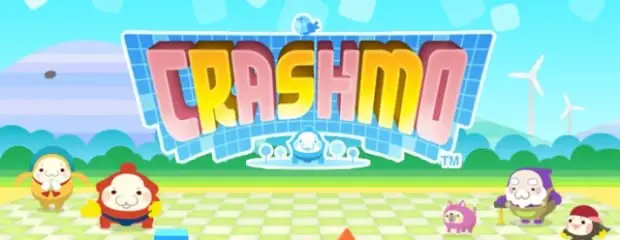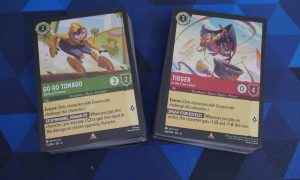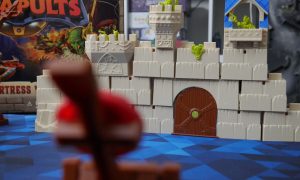 Vibrant pastel colors. Goofy, effervescent charm. A fat, squishy puff-ball wearing a sumo diaper. At first glance, Crashmo appears innocent enough, lowering my guard with its bright cartoon characters and ridiculously cutesy intro. Within the first ten minutes of play, I found myself shouting the most vile swear words at my 3DS on a public train. And yet, even as I was battered, bruised, defeated at every turn, I kept coming back for more.
Vibrant pastel colors. Goofy, effervescent charm. A fat, squishy puff-ball wearing a sumo diaper. At first glance, Crashmo appears innocent enough, lowering my guard with its bright cartoon characters and ridiculously cutesy intro. Within the first ten minutes of play, I found myself shouting the most vile swear words at my 3DS on a public train. And yet, even as I was battered, bruised, defeated at every turn, I kept coming back for more.
[singlepic id=10180 w=320 h=240 float=left]Crashmo is the sequel to Intelligent Systems’ brilliant puzzler Pushmo, and anyone familiar with the previous entry will automatically recognize several key similarities. Pushmo tasked players with pushing and pulling rows of blocks in an effort to create a set of rudimentary stairs to reach the goal somewhere near the top of the puzzle. Usually taking on pictures of various objects, foods, or even Nintendo characters, Pushmo started off slow, gradually increasing the difficulty level as player solved puzzles and learned the ins and outs of the game’s mechanics. Crashmo extends on the core gameplay mechanics of the first game, while adding a few unique twists of its own.
Rather than just pushing and pulling “shelves” of blocks in and out, Crashmo introduces 3D movement. Now, that little puff-ball can slide blocks left and right, in addition to pushing and pulling back and forth. The catch here is that the blocks are not locked in to any one position. Pulling a block on the bottom will cause every single block above it to fall to the floor below – rather than sliding along with the pulled block.
The ability to wrap one’s brain around this concept is paramount to not only progression, but enjoyment; within the first few levels – tutorial levels, mind – I found myself stuck, trying to break through that logical wall and figure out how I can push these blocks together, shift those blocks forward, just to make it to the top. Where Pushmo had a gradual difficulty incline, adding a third dimension to the mix instantly forced me to think completely differently about how I’d tackle each of these puzzles.
[singlepic id=10181 w=320 h=240 float=right]Luckily, Crashmo offers several tutorials for each of the different concepts introduced during each stage, as well as allowing me to skip to the next level whenever I got stuck. There aren’t any real penalties to skipping puzzles – other than missing out on fully completing the game and slightly bruised pride – and it’s a nice feature to keep the game moving forward, rather than halting all progress at a single difficult puzzle.
As Crashmo progresses, new elements are introduced that throw further wrencehes into the mix. Floating blocks keep platforms above-ground; doors and ladders allow for different types of vertical movement; push-buttons move blocks forward without having to push them. All of these elements combine to form newer, more sadistic puzzles which completely belie its cute, marshmallowy exterior.
Despite its rampant difficulty curve, puzzles in Crashmo are hardly unfair. All of them conform to the same rules and physics as every other puzzle in the game, and all of those rules are clearly spelled out at the beginning. There is always a logical progression to each of the levels, making those moments when I finally solved a puzzle that much more satisfying, and those moments where I reached for a walkthrough that much more infuriating – the solutions seem so obvious in hindsight, the hallmark of any well-designed puzzle.
While there are fewer puzzles than its predecessor – 100 compared to the 250 of Pushmo – in this case, less is more as Crashmo never overstays its welcome. The puzzles in Crashmo are much more abstract than they were in Pushmo – they’re a series of differently shaped blocks all in service of the puzzle’s solution, rather than making interesting pictures and shapes – but these are all minor complaints. Crashmo has trimmed the fat, creating a leaner, meaner, block-pushing puzzle game – one that doesn’t beat around the bush with extended tutorials or drawing concepts out farther than need be.
[singlepic id=10179 w=320 h=240 float=left]The Studio has even been brought over completely intact — with all new features — allowing players the ability to craft their own levels. Players can tap away at a giant grid, creating their own designs, using all of the puzzle functionality featured in the main game. Everything is clearly laid out, and creating intricate puzzles are a breeze. Sharing puzzles is even easier: after saving a puzzle, a QR code is created, allowing the puzzle to be easily shared via 3DS or internet. Nintendo has been doling out new puzzles every week or so this way, with plenty more to come.
Crashmo is a natural extension of the concepts introduced by Pushmo. Sure, it gets much harder much faster than Pushmo, but it does so much more with less that it easily surpasses the achievements of its predecessor. What seems like “more of the same” instantly fades away into some of the most brutal, yet logical, puzzles I’ve ever seen. With Crashmo, Nintendo’s best downloadable game just got better.
I've been gaming since my dad made the bad decision of buying me a Nintendo when I was four years old. Every day I'd find myself with my face glued to a TV screen, punching away at buttons, getting furious with Bowser, Dr. Wily, and those freakin' birds in Ninja Gaiden. Since then I have failed to get my parents to play any board game with me, I sold my full copy of Earthbound with box and guide for $300 to some dude in Austria for rent money, and I still believe in Nintendo even after all these years.

See below for our list of partners and affiliates:























